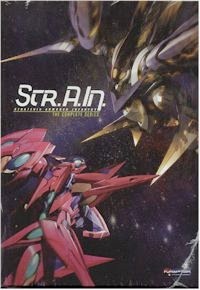Shelf Life
Straining Your I"s
by Bamboo Dong,

Str.a.in Boxset
Rental Shelf
From I"s / I"s Pure Complete Series
Darker than Black DVD 2
Perishable
Love Hina Boxset
Welcome to Shelf Life.
 I'm always pleasantly surprised whenever I enjoy a 13-episode series I've never heard of before. I feel like it's a bite-sized treat that I wouldn't have discovered otherwise, and if it already comes bundled in a boxset, even better. Str.a.in was such a show, and despite being a little skeptical as I read the back of the box, I ended up enjoying it quite a bit. I had actually only planned on watching the first four episodes the first night, and finishing it up the next day, but I found that I couldn't stop until the whole series had reached its conclusion.
I'm always pleasantly surprised whenever I enjoy a 13-episode series I've never heard of before. I feel like it's a bite-sized treat that I wouldn't have discovered otherwise, and if it already comes bundled in a boxset, even better. Str.a.in was such a show, and despite being a little skeptical as I read the back of the box, I ended up enjoying it quite a bit. I had actually only planned on watching the first four episodes the first night, and finishing it up the next day, but I found that I couldn't stop until the whole series had reached its conclusion.The main character is an oddly likeable girl named Sara Werec, who dreams of becoming a Strain pilot and following in her older brother's footsteps. After going to the training academy, she rapidly rises to the top of her class, until one day, their school is attacked by enemy drones called TUMORS. Given the all-caps, I imagine TUMORS is some kind of acronym, but they didn't have to explain what it was in order for the viewer to figure out that they're bad mojo. Turns out, the enemy also has a Strain, piloted by someone who defected from the good side. He's none other than Sara's brother, who's now crazy and just kills people. After failing to defeat him in battle, she vows to kill him. Also, there's a secret alien subplot and a mysterious girl who's crucial to the story, but I don't want to spoil anyone.
Conveniently, the story makes it pretty easy to catch up in case you happen to skip an episode. Rather than having episode recaps, they slyly stick the exposition into characters' dialogues. If you think this sticks out and could be extremely awkward, you'd be right. My favorite was when one of the girls helpfully points out, “Despite being a transfer student, she underwent grueling self-trining and eventually got permission to join the sub-light speed exercises!” Classic.
Now, earlier I said that Sara was “oddly likeable.” I mean that in the sense that for much of the series, she presents herself as very isolated and cold, but with the omniscient view of her life that the viewers are given, we can see sides of her that other characters have to wait for. Sara's one-track devotion to hunting down her brother makes her an admirable heroine, and her calm demeanor in the face of all the bullies at her new academy just bolsters her image. It's not terrible rare to see a stoic-girl-who-is-really-good-at-fighting-but-who-doesn't-really-show-her-emotions-type character in a mecha show, but it's a tried and true formula, and it works in making Sara a strong character—especially when the viewers get to see the contrast between her “public” face and her “private” face.
Notably, the fight sequences in Str.a.in are also really gorgeous. The battles between the Strains and the TUMORS takes their cues from the classic Itano circuses of Macross lore, and they're remarkably elegant. It's kind of great, because you get all the thrill of the action, without having to see every frame of the fight. Even the final battle is more like watching two points of light chasing each other against a black background, and it's more breathtaking than you'd think possible for a hardly-heard-of 13-episode robot show.
I'm not sure how many anime fans have actually heard of Str.a.in, but it's worth checking out. The character development is really strong for such a short show, and the cliffhangers will definitely keep you watching. It may seem like “just another robot show,” but this one's at least really well done.[TOP]
 I was also completely psyched to get a copy of From I”s and I”s Pure, both packaged together in a two-disc set from Viz. For a few years in junior high, Masakazu Katsura was my favorite manga author, and I devoured all of his works that I could get my hands on. Somewhat guiltily, my favorite was DNA^2, but I was fascinated by I”s. I kind of hated all of the characters, but I liked how everything always worked out in the end. You could be the unsuavest mofo in the whole world, but things that are meant to be kind of work out. So, when I heard they were making an anime, I was excited, and now I can finally watch it.
I was also completely psyched to get a copy of From I”s and I”s Pure, both packaged together in a two-disc set from Viz. For a few years in junior high, Masakazu Katsura was my favorite manga author, and I devoured all of his works that I could get my hands on. Somewhat guiltily, my favorite was DNA^2, but I was fascinated by I”s. I kind of hated all of the characters, but I liked how everything always worked out in the end. You could be the unsuavest mofo in the whole world, but things that are meant to be kind of work out. So, when I heard they were making an anime, I was excited, and now I can finally watch it.So there are two OVAs—a two-episode OVA that isn't directly adapted from the manga, and a six-episode OVA that does a reasonably faithful adaptation of the manga. I”s Pure, which is the six-part adaptation, is the better of the two, although it pales in comparison to the manga. It does a good job of retelling the events of the manga, but the limited runtime condenses it quite a bit. There are a few characters who don't get the screen time they deserve (such as the main character's childhood friend), but it serves as a primer to the manga series.
The story stars a rather talentless guy named Ichitaka. He's crushed on his classmate Iori for the longest time, but has never been able to muster up the guts to talk to her. Much of the story is focused on his ongoing struggle to confess his love to her, but misunderstandings keep getting in the way (one of them being the sudden appearance of a childhood friend/love interest, Itsuki). Eventually, the guy gets the girl, but it's not without a lot of bumbling. Personally, I've always found Ichitaka to be a solid lead. He's not particularly good at anything, but he cares deeply about his friends. He's always the one who saves Iori from perverts (because for whatever reason, Katsura romances have a lot of rape danger scenarios), even if it means getting a good whooping. But at the same time, he's a stereotypical teenage male, who's obsessed with panties and constantly fantasizes about seeing his love interests shyly offering themselves to him.
The big downside with the OVAs comes in the fact that you don't really get to see the characters interactions beyond the bare bones of the story. Itsuki ends up showing up for a couple of episodes, just long enough to be the “other girl,” but you don't really see why she and Ichitaka are so drawn to each other. None of the characters' emotions are really explained, beyond a few cursory “I… I guess I like [Ichitaka] best…” remarks, and it strips the show of any character development. It's a shame, because in its current state, it's more like a CliffsNotes for awkward teenage love than anything substantive.
From I”s fares even worse. Taking place during the characters' summer vacations, it tells a rather morbid tale of how all the friends happen to be in the same lakeside resort and manage to prevent Itsuki from getting raped, except there's also a death scene. It's meant to share some background about one of Ichitaka and Itsuki's childhood promises, but unless you've read the manga, you don't really know anything about their relationship (and I”s Pure does not adequately prepare you for this). Instead, it just ends up being a rather creepy story that has way too many kids singing eerie songs, and a story that's more gruesome than gallant.
Sadly, the problems with this release don't stop there. The English voice acting is wooden, and there aren't really any stand-out parts. The exclamations seem out of place, and anything beyond a dead-pan sounds forced. But that's not the problem that irks me the most. Weirdly, the images on the discs were printed wrong. So, the disc that says From I”s actually contains I”s Pure, and vice versa. It's a simple error, and it would seemingly be way more trivial than a clunky dub, but it's so obvious that it makes it worse.
I really, really wanted to like both OVAs. I tried to judge them as standalone series, but they work better as companions to the manga, because they're simply not strong enough to stand up on their own. The characters aren't developed at all (and some of the side characters aren't even introduced!), and all the meat of the relationships has been gutted. If anything, I hope it'll drive fans to check out Viz's release of the manga.[TOP]
 Amongst all the box sets coming out now, there are still a few higher profile series that are slinking out one volume at a time. They're fun to watch, but the wait between discs is kind of brutal. Luckily(?), some of the releases, like Darker than Black, are episodic enough that it doesn't entirely matter, but I still give a cry of disappointment whenever I reach the end of the volume.
Amongst all the box sets coming out now, there are still a few higher profile series that are slinking out one volume at a time. They're fun to watch, but the wait between discs is kind of brutal. Luckily(?), some of the releases, like Darker than Black, are episodic enough that it doesn't entirely matter, but I still give a cry of disappointment whenever I reach the end of the volume.At the core of Darker than Black is the underlying mystery of what exactly happened to make the Hell's GATE appear in Tokyo, and what purpose it serves. Since that time, the stars in the sky have disappeared, replaced by fake stars that correspond to people known as Contractors—people who can use special abilities at a price to themselves. Some of them have to let their own blood (lucky for that guy, he can use his blood as an explosive), some of them have to make their murders look like suicides. Others just have to eat flowers. It's kind of a gimmicky set up, but the series delights in pointing out all the Contractor's payments, as though viewers somehow care. Conveniently, the main character inherited his electricity-conducting powers, so he doesn't even need to pay up. This allows him to go around and help track down other Contractors without us having to watch him go through any gruesome (or silly) after effects.
Just like in the first volume, this set of episodes is comprised of a few standalone mini-arcs, usually culminating in the defeat or retreat of an enemy Contractor. This exposes viewers to some of the more unique bad guys, and presumably sets up the story for the return of some of the dangerous ones, but it still doesn't let on any secrets pertaining to Hell's GATE. As disappointing (and understanding) as that is, these episodes do provide some backstory on some of the other major characters, like the police section chief. Everything else was just action-oriented mind-fluff, which would be fine, if I weren't waiting a month between releases to figure out what happens next.
Having seen ten episodes of this show now, I can't really figure out what's that special about it. It's entertaining, but there's nothing that stands out about it. The animation isn't particularly impressive, nor is the mildly awful soundtrack mainly comprised of guitars wailing the same power chords over and over again. One thing that I'll commend the series for is the way that the battles are depicted. It's not easy to make supernatural battles look believable, but the way they use lighting in this show really draws out the action, whether it's the glint of Li's wires, or the various glowing things that everyone uses in one form or another.
Darker than Black would be fun to watch if you had absolutely nothing else to do with your time, but it's not something that would greatly impact your life if the rest of the series was never released. Maybe if it was closer to the end and viewers were closer to figuring out the whole Hell's GATE business, but right now, it's just another assassin-does-awesome-things show.[TOP]
 Now, the last item on my list goes with a bit of a backstory. When I first started watching Love Hina, I thought it was the funniest show in the world. Of course, back then, I also thought that Lost Universe was the funniest show in the world. At the time, I had never seen an anime series whose comic strength was the sheer randomness of the events. One minute, tanks were being driven through Hinata Inn—the next, the characters were in a mock RPG video game. I thought the girls were a boatload of fun, and I couldn't get enough of the turtle.
Now, the last item on my list goes with a bit of a backstory. When I first started watching Love Hina, I thought it was the funniest show in the world. Of course, back then, I also thought that Lost Universe was the funniest show in the world. At the time, I had never seen an anime series whose comic strength was the sheer randomness of the events. One minute, tanks were being driven through Hinata Inn—the next, the characters were in a mock RPG video game. I thought the girls were a boatload of fun, and I couldn't get enough of the turtle.By the time I got to the middle of the series, my infatuation with the show was rapidly wearing off. The jokes were starting to stagnate, and the girls I had loved so much just a few episodes were getting under my skin—especially Naru. I couldn't stand her impatience with Keitaro, and every time one of the girls punched him for something that was clearly their fault, it drove me wild. By the time the show was over, I hated it. (Out of nostalgia for my old feelings, I still continued buying Love Hina merchandise for years.)
So several years later, I'm watching Love Hina again. Funimation has procured the rights and has released the whole series in a thinpak boxset. Much to my chagrin, I realized that not only did I still dislike the series, but that on second viewing, I even hated the first several episodes, since they just foreshadowed what would eventually happen.
For those who are unfamiliar with this somewhat classic harem show, Keitaro is the bumbling (but sweet) male lead who's failed his university exams twice. He ends up as the manager of an all-girls' hot springs as a favor to a relative, and suddenly finds himself surrounded by women. His main love interest is a bright girl named Naru, whom we assume also likes him. However, Every Little Thing he does is met with derision and contempt, and she ends up punching him an awful lot. If she bursts into his room wearing nothing but a towel, he gets punished for it. If she trips and falls on him, he gets punished for it. Somewhere, somehow, this qualifies as comedy. For me, it's just irritating, and I find it hard not to wish ill upon her. I don't understand why Keitaro likes her, thus I find it hard to care about what happens in the show. Some of the other girls are a lot of fun, but they're side characters compared to what's going on in spotlight, so they seldom get any credible screen time besides serving as diversions.
One thing that I've always really admired about Love Hina though, are the absolutely gorgeous backgrounds that the series uses. Even now, I have to admit that the backgrounds look just as gorgeous now as they did so many years ago. Everything is lovingly detailed with what looks like watercolors, and when I see a gorgeous rendering of Hinata Inn, I momentarily forget what banshees are inside. The actual animation itself isn't much to look at, but it gets the job done, and it shows off the backgrounds quite well.
A lot of fans still like Love Hina to this day. I know that I will probably be attacked for not liking the series, but I find it very difficult to sit through—especially a second time. Whereas the manga focuses more on the characters and their relationships with one another, the anime spends most of its time on goofy, unfunny slapstick. The childhood promise that Keitaro made to his friend to attend the same university as her is really sweet, and ultimately, Love Hina is a great love story. But not in the anime. There are some tender moments when Naru stops being a witch for a few minutes, but those are invariably interrupted by one of the other girls bursting in and doing something absurd. The constant barrage of slapstick is exhausting, and if you can handle it, all the more power to you.[TOP]
Alright, that's enough for this week. Thanks for reading!

This week's room o' stuff is from Dave:
Hi my name is David and I have been collecting for 5 years now. I got into collecting anime from my freinds that i met at my university anime club which I am now the Vice Pesident of.
I am extremely proud of the fact that I no longer download fansubs and I buy everything legitimatly.
This Is showing all of my dvds and about a quarter of my manga that I own. plus the fact that I always have more stuff coming in.



















Absolutely nuts. Also, huge props on owning SaiKano. :D
Want to show off your shelves? Send your jpgs to shelflife at animenewsnetwork dot com. Thanks!
discuss this in the forum (103 posts) |
this article has been modified since it was originally posted; see change history